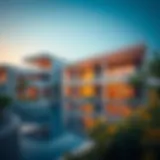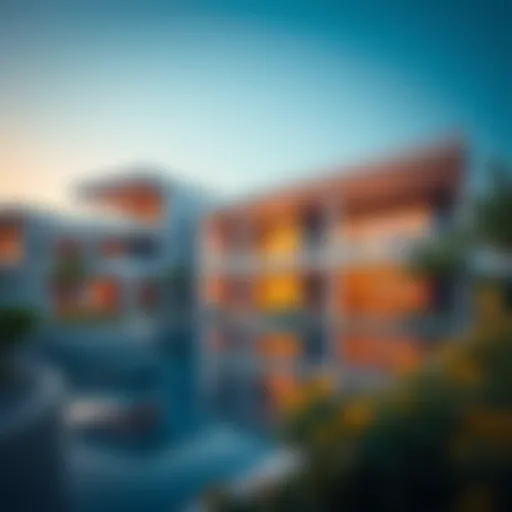Top Residential Buildings in Dubai: A Comprehensive Guide
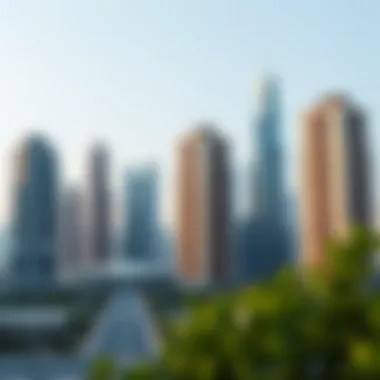

Intro
Dubai, a shimmering oasis in the desert, is known for its rapid transformation and breathtaking skyline. The city offers a unique blend of traditional culture and modern extravagance, making it a magnet for investors and homebuyers alike. In the world of real estate, Dubai stands out not just for its iconic structures but also for the diverse living spaces that cater to the eclectic tastes of its residents.
Market Trends
Current Real Estate Market Insights
The Dubai real estate market has shown remarkable resilience in recent years. Despite global economic fluctuations, demand for properties remains steady. Particularly, luxury residential buildings command a premium, drawing attention from international buyers. According to recent reports, rental yields in locations like Dubai Marina and Downtown Dubai hover around 6-8%, an attractive proposition for many investors.
The trend towards sustainability is also becoming a prominent feature. Developers are focusing on green building practices, incorporating energy-efficient features and sustainable materials. This shift not only reflects global priorities but also enhances property values, appealing to environmentally conscious buyers.
Future Predictions and Investment Opportunities
Looking ahead, experts predict continued growth in the sector, particularly in areas such as Jumeirah Village Circle and Dubai Creek Harbour. These neighborhoods are expected to see significant infrastructure investments and further development of community amenities. Potential buyers should keep an eye on upcoming projects and government initiatives, as these can offer enticing investment opportunities. Ultimately, the vision for Dubai’s future is ambitious, with a goal to become one of the world’s top global cities by 2030.
"The future of Dubai’s real estate is shining bright. Opportunities abound for those willing to navigate the market thoughtfully."
Property Listings
Featured Luxury Properties
For those seeking opulence, several residential buildings in Dubai offer unparalleled luxury. Some of the most notable include:
- Burj Khalifa Residences: Living here equates to experiencing the splendor of being in one of the tallest structures in the world while enjoying state-of-the-art amenities.
- Dubai Marina Towers: These iconic towers present breathtaking views of the marina and access to a sandy beach just a stroll away.
- Palm Jumeirah Villas: Nestled on the famous palm-shaped island, these properties provide exclusive beach access and lavish interiors.
Affordable Housing Options
On the other side of the coin, Dubai also has a plethora of affordable housing options that don’t skimp on quality. Noteworthy mentions include:
- Akoya Oxygen: Designed as a community for families, it offers villas and apartments at competitive prices, complete with parks and schools nearby.
- Dubai South: Known for being the host of Expo 2020, this area has launched various affordable projects aimed at young professionals and families.
As the market continues to evolve, potential homeowners and investors should be mindful of the diverse options available. Assessing one’s lifestyle needs against investment opportunities can lead to informed decision-making, ensuring long-term satisfaction in one’s choice of residence.
Prelims to Dubai's Real Estate Landscape
Dubai's real estate has become a buzzword in the world of property investment, attracting investors, expatriates, and architects from all corners of the globe. The sheer scale of development in this desert city is not just impressive; it’s downright mind-boggling. From resplendent skyscrapers to lavish villas, every structure seems to narrate a different story of ambition and innovation. Grasping the dynamics of Dubai's real estate landscape is crucial for anyone looking to delve into this vibrant market.
With a range of factors influencing property values and investor confidence, it’s vital to understand not just the buildings but also the trends and market impulses that shape this sector. The fusion of economic growth, diverse cultural influences, and government initiatives create a unique backdrop for potential investors. Knowing how these dynamics operate can lead to better investment decisions and a fuller understanding of the market’s offerings.
Understanding the Market Dynamics
The market dynamics in Dubai are as intricate as the city’s many architectural marvels. Factors such as supply and demand fluctuations, the influx of expatriates, and tourism levels play a significant role in how properties are valued and sought after. After the global economic crisis in 2008, the market experienced a significant downturn, but since then, it has witnessed a remarkable recovery.
Getting a grip on these dynamics offers a clearer picture. Investors usually look at metrics like rental yields, occupancy rates, and demographic shifts. For instance, as more international businesses establish their roots in Dubai, the demand for residential properties has soared, driving prices up. However, because the city also emphasizes creating new developments, there’s a balanced mix of availability in the market. This dynamic can lead to opportunities if one is willing to navigate the intricacies and remain vigilant about upcoming trends.
Key Trends in Dubai Real Estate
The real estate market in Dubai is a living, breathing entity, constantly evolving under the influence of multiple key trends. Here are several notable ones:
- Sustainability Focus: There’s a pronounced pivot towards eco-friendly buildings, integrating smart technologies, and sustainable materials in construction. Developers are increasingly aware of the need for greener living environments in response to global climate concerns.
- Mixed-Use Developments: More properties are being designed to cater to various needs, combining residential living, retail spaces, and recreational areas. This approach is not only about convenience but also about creating vibrant communities.
- Short-Term Rentals: The rise of platforms like Airbnb has popularized short-term rentals, especially among tourists and expatriates who are temporarily in the city. This trend is changing how investors approach their properties, often adapting them for short-term leasing to maximize returns.
- Government Initiatives: The government has introduced several measures to attract foreign investment, including granting longer residency visas and easing ownership laws for expatriates. These initiatives are encouraging more investors to consider owning property in Dubai.
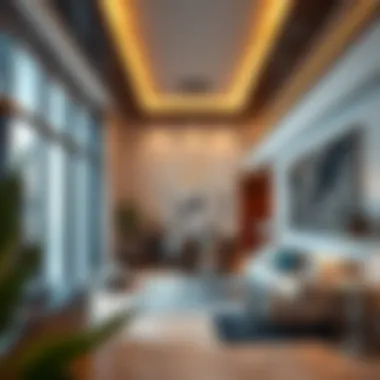

Understanding these trends gives potential buyers and investors an edge, helping them to align their strategies with market movements. Keeping abreast of these elements creates pathways for informed decision-making and targeted investments.
Architectural Marvels of Dubai
The architectural landscape of Dubai stands as a testament to human ingenuity and ambition. The architectural marvels deeply influence the real estate market, drawing the attention of investors, residents, and tourists alike. Each building serves not just as a place of dwelling but as a symbol of the city's rapid growth and modernity. In this section, we delve into the blend of extravagant designs and practical living spaces that shape the property scene in Dubai.
Fusion of Modern and Traditional Design
In Dubai, it’s fascinating how skyscrapers made of glass and steel coexist beautifully with traditional Islamic designs. Modern architecture often incorporates elements from Emirati heritage, creating a fusion that respects the past while embracing the future. For instance, the spire of Burj Khalifa, while undeniably sleek and contemporary, evokes the minarets adorning traditional mosques.
This blend of styles adds value, making properties more appealing to a diverse group of buyers. Whether it’s the intricate geometric patterns or the grand arches, each design choice tells a story, making residents feel rooted in both the history and the progress of their home.
Benefits of This Fusion
- Cultural Representation: By integrating traditional elements, buildings honor the UAE's rich heritage.
- Aesthetic Appeal: Unique designs draw eyes and admiration, which can enhance property value.
- Market Differentiation: Distinct spaces attract various buyers looking for something beyond just a living space.
Landmark Developments
When we talk about landmark developments, it’s hard to overlook structures like The Address and Bluewaters Island. These developments have not only changed the skyline but also set benchmarks for luxury living in the region.
For instance, The Address Boulevard stands proud with its high-end amenities and vibrant city life around it. It offers residents direct access to shopping, dining, and entertainment, making it one of the most coveted places to live. On the other hand, Bluewaters Island presents a unique coastal living experience with its stunning views and vibrant atmosphere.
The significance of these landmark developments goes beyond just luxury. They have catalyzed growth in surrounding areas, making them attractive investments for those keen on real estate.
In sum, the landmark properties of Dubai are more than impressive structures; they are catalysts for economic growth and indicators of market trends. Investors often look at these developments as safe bets, appreciating their resilience and potential for high returns.
"Investing in real estate means buying into the future - and in Dubai, the future is now, beautifully interwoven with its past."
In summary, architectural marvels in Dubai do more than just provide living spaces; they represent a remarkable blend of culture, innovation, and prestige that collectively enhances the city’s real estate dynamics.
Overview of Premier Residential Buildings
In the context of Dubai's diverse real estate market, the premier residential buildings represent the pinnacle of luxury living, architectural innovation, and investor appeal. These properties not only offer high-end amenities but also play a crucial role in defining the city’s skyline and lifestyle. With a rich blend of styles ranging from ultra-modern aesthetics to traditional influences, Dubai’s residential offerings attract a myriad of buyers, investors, and renters alike.
The importance of exploring these premier buildings lies in understanding what makes them stand out. Key elements include their architectural design, location, and amenities which all contribute to their desirability. Furthermore, knowing the various aspects of these properties can aid potential homebuyers and investors in making informed decisions based on their preferences and objectives.
- Architectural Excellence: Each building tells a story, reflecting cultural aspects as well as modern design tendencies. This brings a unique flavor to each property, enticing buyers who appreciate artful creations.
- Strategic Locations: Being in prime areas adds to their appeal. The proximity to work, leisure activities, and community services often defines the worth of a property.
- Investment Advantages: With Dubai being a global hub, properties in these coveted areas typically see higher appreciation rates over time. This provides a strong foundation for investors looking to maximize their return.
In essence, the overview of premier residential buildings is not just about properties; it’s about the lifestyle associated with them and the investment opportunities they present. Understanding this segment is essential for anyone looking to navigate the complex realm of Dubai’s real estate.
Comparative Analysis of Key Properties
Understanding the intricacies of the residential landscape in Dubai goes beyond merely identifying individual buildings. A comprehensive comparative analysis of key properties can provide invaluable insights into the varying standards of living, investment viability, and market trends that define this bustling metropolis. By evaluating distinct properties side by side, investors, homebuyers, and realtors can make informed choices tailored to their aspirations and financial goals.
Luxury versus Affordable Living
The divide between luxury and affordable living in Dubai is significant, and knowing where one stands can mean the difference between a financially sound decision and a regrettable misstep. Luxury properties, such as those found in the Burj Khalifa or Palm Jumeirah, offer unparalleled amenities and exclusivity. These high-end residences are often equipped with state-of-the-art facilities, private pools, and concierge services, catering to a clientele that seeks more than just shelter— they seek a lifestyle.
In contrast, affordable living options, often situated in areas like Al Quoz and Discovery Gardens, provide a more budget-friendly entry into the Dubai real estate market. These properties may lack some of the opulence of their luxury counterparts, but they come equipped with essential amenities that cater to a different demographic. Each category presents its own unique set of advantages and drawbacks that potential buyers should carefully weigh.
- Luxury Living:
- Affordable Living:
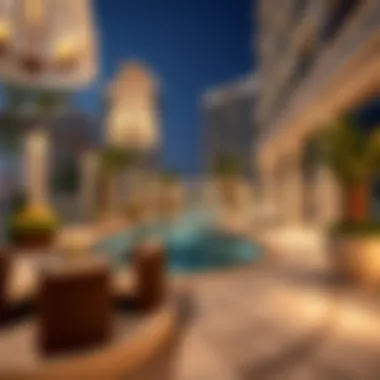

- Pros: Top-notch facilities, prime locations, high appreciation rates.
- Cons: High entry costs, ongoing expenses, and less flexibility in terms of investment returns.
- Pros: Lower price point, broader accessibility to varying demographics, potential for significant rental yields.
- Cons: Lesser amenities, possible trade-offs in terms of location and living space.
Ultimately, the choice between luxury and affordable living hinges on individual priorities and long-term goals. Whether one's focus is on enjoying an elite lifestyle or securing a solid investment base, the Dubai market has something to accommodate diverse needs.
Long-Term vs. Short-Term Rental Opportunities
In a city infused with an ever-changing landscape, the type of rental opportunity one opts for has substantial implications on the investment's return. When considering long-term vs. short-term rentals, it becomes clear that each has its unique set of benefits and challenges.
Long-term rental properties generally appeal to families and professionals seeking stability, often leading to steady cash flow over extended periods. Investors can enjoy the security of tenant contracts that may last for several years. Locations near schools or business districts typically attract long-term tenants, making them sound choices for those looking to establish a consistent income stream.
Conversely, the appeal of short-term rentals, particularly in tourist hotspots like downtown Dubai or the Jumeirah Beach areas, cannot be underestimated. These properties offer the allure of increased nightly rates and can lead to remarkable returns during peak tourist seasons. However, they come with their own complexities, including fluctuating occupancy rates and the requirement for continuous property management and maintenance.
Key Considerations:
- Long-Term Rentals:
- Short-Term Rentals:
- Stability for investors.
- Fewer management demands once tenants are secured.
- Potential for higher income during certain times of the year.
- Requires more operational oversight and marketing efforts.
When deciding on the type of rental strategy, investors must assess their cash flow preferences, tolerance for risk, and engagement in property management. Navigating these choices successfully can pave the way to fruitful investment ventures in Dubai’s ever-evolving real estate sector.
The decision to invest in luxury or affordable living, and whether to pursue long-term or short-term rentals, can significantly impact success within Dubai's unique real estate market.
By conducting a thorough comparative analysis, stakeholders can position themselves to capitalize on opportunities and navigate the complexities of Dubai's vibrant property market.
Neighborhood Insights
Understanding the neighborhoods in Dubai is vital for anyone looking to invest or reside in this bustling city. The choice of neighborhood can shape an individual's experience in Dubai, affecting everything from accessibility to local amenities and community vibe. As varying areas evolve, their unique characteristics often influence property values and lifestyle options.
Vibrant Cultural Hubs
Dubai is home to several neighborhoods that act as cultural melting pots. Areas like Al Fahidi and Jumeirah maintain a traditional charm while incorporating modern touches. They boast art galleries, historical sites, and cultural events that dive deep into the rich history of the region. Living or investing in these cultural hubs means being part of an ecosystem where art, tradition, and modernity collide.
- Local Festivals: Art Dubai and the Dubai Design Week attract international visitors, showcasing local talent
- Culinary Diversity: A medley of dining options, from street food to upscale restaurants offering international cuisine.
- Community Events: Frequent markets, exhibitions, and performances that open doors to the local lifestyle.
Choosing a home in these vibrant cultural hubs often means a richer, more immersive living experience. Investors typically prefer properties near these attractive features for their potential appreciation in value.
Emerging Areas with High Potential
Several up-and-coming neighborhoods in Dubai signals a goldmine for savvy investors. Areas like Dubai South and Mohammed Bin Rashid City are on the rise, thanks to ongoing developments and investments.
- Infrastructure Growth: With the new airport and extensive transport links, commutation becomes hassle-free.
- Affordability: These regions often provide more value for money compared to established districts.
- Community Aesthetic: Many developments prioritize green spaces and recreational facilities, appealing to families and young professionals alike.
Investing in these emerging areas not only promises growth in property value but also a sense of belonging in newly forming communities.
Established Districts
The established districts like Downtown Dubai and Dubai Marina epitomize luxury and convenience. These neighborhoods have solidified their status, boasting iconic landmarks, high-end shopping, and stunning waterfronts. They cater to an affluent clientele, which elevates their attractiveness for both buyers and renters.
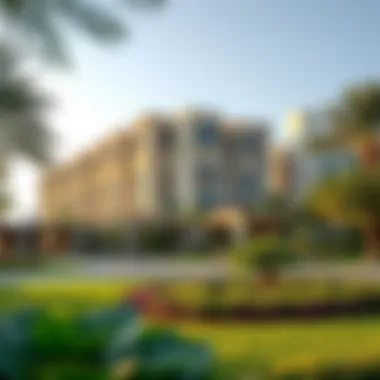

- Consistent Demand: Properties in these areas maintain high occupancy rates, ensuring a steady return on investment.
- Luxury Amenities: Access to top-notch facilities like gyms, pools, and fine dining enhances the living experience.
- Central Location: Proximity to business hubs and key attractions fosters a vibrant community dynamic.
Investors should consider established districts not just for immediate returns but also for long-term appreciation. Owning a property in these areas can be viewed as an investment in status and convenience.
"Finding the right neighborhood is as crucial as the property itself; it's where lifestyle and investment value intertwine."
In sum, these neighborhood insights provide potential homeowners and investors with a clear perspective on the various facets and offerings that Dubai’s residential landscape presents. Understanding these elements not only helps in making informed decisions but also enriches the overall living experience in this cosmopolitan city.
Investment Considerations
Investment in real estate, especially in a market as diverse and dynamic as Dubai's, comes with its set of advantages and challenges. Understanding the nuances of this market is crucial for anyone looking to make informed decisions. Whether you're a seasoned investor or a prospective homeowner, grasping the salient features of the investment landscape is vital. This section will delve into the benefits of investing in Dubai's residential buildings and the considerations that prospective buyers should keep in mind.
Market Stability and Trends
Dubai's real estate market has shown resilience over the years, even amidst global economic fluctuations. In the wake of the 2020 pandemic, property prices dipped; however, the market has been on a steady recovery trajectory. It's essential to study prevailing trends such as demand for luxury living spaces and shifts in buyer demographics, as these factors can significantly influence property value.
Structured developments like Expo 2020 site and various sustainability initiatives have enhanced the city's appeal, making it not just a transient hub but a long-term residential destination. The government continues to introduce favorable policies aimed at attracting foreign investment, which bolsters confidence.
Some key market trends are:
- Increased demand for luxury apartments: High-net-worth individuals show a preference for lifestyle-oriented amenities.
- Sustainability focus: Eco-friendly buildings and smart living are now trending, aligning with global standards.
- A shift towards suburban living: More people are moving to areas that offer larger spaces and quieter environments.
Investing in Dubai real estate means more than just purchasing property; it’s about securing a stake in an evolving market that prioritizes innovation and sustainability.
Legal Aspects of Property Ownership
Navigating the legal framework for property ownership in Dubai can be quite intricate, but it's a necessary endeavor for any informed investor. Dubai offers a range of legal ownership structures, including freehold and leasehold agreements, which can significantly impact ownership rights and resale potential.
Freehold Ownership
Freehold ownership allows for complete control of the property, making it a popular choice among foreign investors. It provides the freedom to resell or lease your property whenever desired without many restrictions. Some notable areas where freehold ownership is available include Dubai Marina and Palm Jumeirah, fulfilling the desire for luxury living.
Leasehold Ownership
In contrast, leasehold ownership typically secures rights for 99 years, after which the property reverts back to the landowner. This is prevalent in certain districts and can be attractive for those looking for shorter-term investments.
Essential Legal Considerations
- Title Deeds: Ensure that the property has clear and legitimate title deeds to avoid future disputes.
- Registration: After purchase, registration with the Dubai Land Department is obligatory, which protects your ownership rights.
- Developer Reputation: Always conduct due diligence on the project developer. A reputable developer can minimize risks associated with potential delays and defects.
Investing in real estate in Dubai is not just about the property itself; it flows into a broader ecosystem of legal, economic, and cultural factors. Understanding these aspects not only minimizes risk but maximizes the potential for lucrative returns.
End
As we wrap up our exploration of Dubai's finest residential buildings, it's crucial to reflect on the various dimensions that make this topic so integral to the current real estate landscape. The significance of understanding the implications of residential choices extends far beyond mere aesthetics or convenience. When looking at these properties, investors, homeowners, and renters alike must consider factors such as market trends, community dynamics, and long-term benefits.
The Future of Residential Living in Dubai
Dubai's real estate sector is not the same as it was a decade ago. It’s evolving at lightning speed, and the future of residential living in this city looks incredibly promising. Innovations in technology, sustainability practices, and design are rapidly reshaping the environment in which people live and thrive.
As demand for housing continues to rise, there's a noteworthy shift attributed to the influx of expatriates and various professionals seeking new opportunities in the region. In addition, the local government’s commitment to enhance infrastructural development supports future growth.
- Smart Living: The use of smart technology in residential buildings is becoming increasingly prevalent. Many new projects are equipped with home automation systems that allow residents to control their environment at the touch of a button.
- Sustainable Design: Eco-friendly designs and green building initiatives are making headway, aligning with global trends toward sustainability.
- Enhanced Amenities: Future developments are expected to offer a richer array of community amenities, focusing more on lifestyle enhancements, such as co-working spaces, recreational zones, and wellness centers.
Investors interested in Dubai's real estate market should keep an eye on these trends. Properties that exhibit these attributes may gain more value over time, making them promising investments.
"In Dubai, every building tells a story of innovation and ambition—a future not just imagined, but actively being constructed."
By understanding these pivotal shifts in Dubai’s residential sector, stakeholders can navigate the complexities of this market more effectively, paving the way for smarter choices in their residential endeavors.










